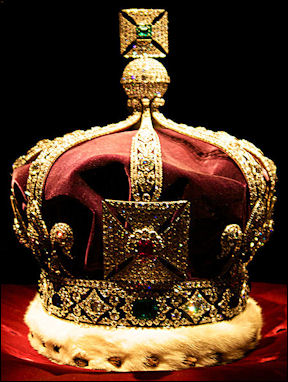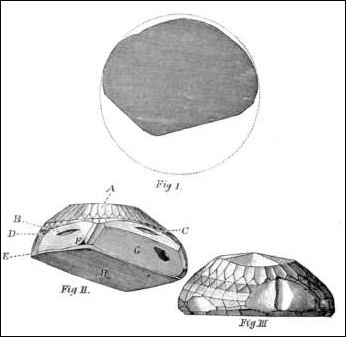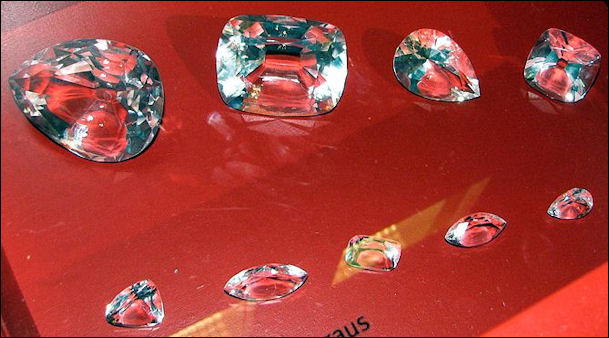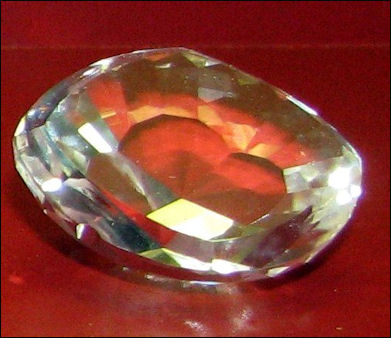FAMOUS DIAMONDS

England's Imperial
Crown of IndiaThe largest diamond in the universe found thus far is the size of a small planet and was found in the constellation Centaurus 50 million light years from Earth. Discovered in the early 2000s by scientists at the Harvard-Smithsonian Center for Astrophysics, this diamond is more than 4,000 kilometers wide and once served as the heart of a star. Its estimated size: ten billion trillion trillion carats.
The world's largest diamond — a 545.7-carat brown monster cut from a 755.5-carat rough diamond found at the Premier Mine in South Africa — was given to the King of Thailand by a consortium of Thai businessmen. Named the Golden Jubilee, it is 15 carats larger than the Cullinan.
The 203-carat De Beer Millennium star is regarded as the most perfect large diamond. Valued at $80 million, it is a flawless pear-shaped gem. It was worn by the supermodel Imam in Tokyo in 2002 to mark the opening of De Beers LV’s Japan operations. The Hope Diamond is regarded as the world largest, flawless blue diamond. Mined in India, it is blue-gray in color and is displayed at the Smithsonian in Washington. One of the unusual things about it and some other blue diamonds is that they glow a a bright, orangish amber color when exposed to ultraviolet light. The color lingers for several seconds after the light is turned off. Scientists do not know why this occurs.
The Hope Diamond is believed to have been mined in India. It had a reputation of being cursed because it was said that every one who owned it came to a disastrous ending. The demand entrepreneur Harry Winston purchased it in 1949 and traveled with it often, without any misfortunes. He donated it to the Smithsonian in 1958, where it is now rests in the Harry Winston Gallery.
According to the Guinness Book of Records, the highest price diamond was purchased on May 17, 1995 at Sotheby's in Geneva by Sheik Ahmaed Fitaihi of Saudi Arabia. Named the Star of the Season, it os a 100.1-carat pear- shaped "D" flawless diamond. It sold for $16,548,750. In November 2007, a huge flawless brilliant-cut 84.37-carat white diamond was sold for $16.21 million at a Sotheby’s auction to Guess Jeans founder George Marciano, who named it the “Chloe Diamond” after his daughter.
Koh-i-noor Diamond
The Koh-i-noor, a 106-carat diamond cut from a 186-carat diamond from the Kollur mine in southern India, is one of the world's most famous gem stones and arguably the one with the most colorful stories surrounding it. According to legend whoever possessed it would rule the world. “It is so precious,” one writer wrote, “that a judge of diamonds valued it at half the daily expense of the whole world.”

Koh-i-Noor by Tavernier
Perhaps the first extremely large diamond ever discovered, The Koh-i-noor was first reported in 1304 as a possession of an Indian Raj. Later it fell into the hands of Baber, the founder of the Moghul empire in India. Britain obtained it when Lahore and the Punjab became part of the British Empires. It was the centerpiece of a crown made for Queen Elizabeth in 1937. It currently resides in the crown of the Queen Mother of England.
In 1739, Persian king Nadir Shah invaded India and overthrew the Moghuls and spent 58 days looking for the Koh-i-noor. According to one story he was tipped off by a courtesan that the captured Mogul leader was carrying the egg-sized diamond in the folds of his turban. Nadir Shah tricked his rival into trading turbans. When the enormous diamond feel to the floor, the shah exclaimed "Koh-i-noor" ("Mountain of Light"). After the shah died one of his sons chose to die by torture rather than disclose where the diamond was.
The Koh-i-noor diamond is reportedly cursed and over the years fell into many different hands. Princes betrayed each other to try and get a hold of it after a maharajah who possessed it failed to produce a suitable heir even though he had several wives and more than 100 concubines A 19th century Afghan prince endured blinding and days of torture before he gave it up, saying he wanted it because it gave him good luck.
The Koh-i-noor diamond passed from Afghans to Sikhs and finally to the British Raj, who took it from 8-year-old Duleep Singh, ruler of the Sikhs, after a fierce battle. After it was shipped to England it “spent six weeks in a forgetful coachman's waistcoat." Today many Sikhs want the British to return the Koh-i-noor diamond. Sandhawalia, a simple farmer and the last surviving heir to Duleep Singh, have filed a suit for the diamond's return
In England, the Koh-i-noor diamond was presented to Queen Victoria as a gift. The royal family found the diamond dull. In 1852, the diamond was recut from 186 carats to its present 108.93 carats to bring out it inner fire and greater brilliance. Still most everyone was disappointed. Some attribute Queen Victoria's trouble to the curse of the diamond. The Koh-i-noor diamond was last worn in 1937 by the late Queen mother at the coronation of her husband, King George VI. It now sits in a vault with the other Crown Jewels in the Tower of London.
Cullinan
For many the Guinness Book of Records listed the largest finished diamond in world as the Cullinan I, or the Great Star of Africa, a 530.2-carat stone that adorns the Royal Scepter in the British Crown Jewels at the Tower of London.
The Cullinan I was derived from a fist-size 3,106-carat (1.3 pound) mother stone that remains the largest uncut diamond ever found. Discovered on January 26, 1905, it was removed with a penknife by a mine manager from the wall of a 30-foot-deep pit in the Premiere Mine near Pretoria, South Africa In addition to the Cullinan I, the mother stone yielded the 317.4 carat Cullihan II, nine major stones and 96 smaller ones. The Cullihan II now lies in English royal crown.
The Cullinan diamonds are named after Thomas Cullinan, discoverer of the Premier mine. The mother stone was bought by the Transval government and given to King Edward VII on his birthday. The huge diamond reportedly was not delivered by courier but rather was mailed third class from South Africa to London in a brown paper envelope because Scotland yard believed that this was the safest way to transport it.

Cullinan rough pieces
The Cullinan was cleaved by the famous diamond cutter Joseph Asscher, who studied the stone for six month before dividing it into two pieces. After he struck the famous diamond, successfully dividing it the way he wanted, he reportedly fainted and collapsed on the floor of his workshop.
High-Priced Diamonds
The highest auction price ever paid for an item of jewelry is $6.2 million for two pear-shaped diamond drop earrings of 58.6 and 61 carats bought and sold anonymously through Sotheby's of Geneva. According to the Guinness Book of Records, the highest price paid for a rough diamond was $10 million for a 255.1-carat stone from Guinea by William Goldberg Diamond Corporation and Chow Tai Fook Jewelry of Hong Kong in 1989.
In 2009, a flawless 7.03-carat blue diamond was sold at an auction for $9.49 million, in Geneva. It was the highest price paid per carat ever. The rectangular-shaped vivid blue stone went to anonymous bidder by telephone. According to the Guinness Book of Records, the highest price paid per carat paid before that was $926,315 a carat for a 0.95 carat fancy purple-red stones sold at Christies in New York on April 1987.
The largest yellow diamond ever found was 890 carats.
The 273-carat Centenary has been described as "best stone of earth actually."
The world’s 18th largest diamond was discovered in Lesotho in 2007. The uncut 493-carat diamond was expected to fetch about $10 million at auction when it was sold. The largest heart-shaped diamond ever offered in an auction was 101 carats and valued at $10 million.
Rare Yellow Diamond Sold for $10.9 Million
In November 2011, a rare yellow pear-shaped diamond was sold for $10.9 million at a Sotheby’s auction in Gneva. AP reported: “The so-called Sun-Drop Diamond is described as fancy vivid yellow — the highest color grading — by gemstone experts. It is the largest known diamond of its kind, at 110.3 carats.” "It looks the weight," said David Bennett, the head of Sotheby's jewelry division. "At the same time it's a very bright stone," he added, as a model showed off the diamond to photographers before the sale at Geneva's Beau-Rivage hotel. [Source: Frank Jordans - Associated Press, November 10, 2011] The jewel was sold by Cora International, which discovered the diamond in South Africa in 2010 — meaning it has no history of previous wearers. "Some people find it very attractive to own a stone that's been lying untouched in the earth for millions of years," Bennet told The Associated Press.

copies of the Cullinan Diamond and some of its cuts
Pink Diamond Sold for $46 Million
In November 2010, Sotheby's sold a 24.78-carat fancy intense pink diamond for a record-breaking $46 million. The emerald-cut diamond had a pre-sale estimate of $38 million. Frank Jordans of Associated Press wrote: “A rare pink diamond smashed the world record for a jewel at auction Tuesday, selling for more than $46 million to a well-known gem dealer. London jeweler Laurence Graff paid $46,158,674, for the 24.78-carat "fancy intense pink" diamond, which he immediately named "The Graff Pink." [Source: Frank Jordans, Associated Press, November 16, 2010]
“It is the most fabulous diamond I've seen in the history of my career and I'm delighted to have bought it," Graff said in a statement released by auction house Sotheby's, which offered the stone at its Geneva sale. The sale price was almost double the $24.3 million achieved by the blue 35.56-carat Wittelsbach-Graff diamond in 2008. That was also bought by Graff.
“This is the highest price ever bid for a jewel at auction," said David Bennett, the head of Sotheby's jewelry division, as the auction room in Geneva's luxury Beau Rivage hotel erupted into applause. "Everybody was surprised it went that high," Mart van Drunen, a jeweler from Amsterdam, commented after the sale. "He clearly wants to have all the rarest diamonds in the world.”
“Rich buyers from developing countries have been dipping their hand in the high end of the market in recent years, but experts say emerging middle classes particularly in India are doing as much if not more to lift prices. Ongoing doubts about the stock market have also helped drive up the value of gold and precious jewels, said van Drunen. Four bidders competed for the pink diamond, which was last sold 60 years ago by New York jeweler Harry Winston. The seller chose to remain anonymous, said Sotheby's.
“Graff had the blue diamond recut after purchase, to the displeasure of purists who considered it an act of vandalism against a unique object. It wasn't immediately known whether he planned to alter the pink diamond, which Sotheby's says has a flaw unnoticeable to the naked eye but may be graded as internally flawless after re-polishing. Sotheby's said it sold jewels worth $105.1 million, also a world record for a single sale. The auction included items once belonging to Christina Onassis, the daughter of the Greek shipping tycoon Aristotle Onassis, and Cristina Ford, the second wife of Henry Ford's grandson Henry Ford II.
Large Pink Diamond Found in Australia

Koh-i-Noor, old-version copyIn February 2012, AFP reported: “Mining giant Rio Tinto said it has unearthed a "remarkable" 12.76 carat pink diamond in Australia, the largest of the rare and precious stones ever found in the resources-rich nation. Named the Argyle Pink Jubilee, the huge rough stone was found at Rio's pink diamond operations in the Kimberley region of Western Australia and would take 10 days to cut and polish, the miner said on Wednesday. "This rare diamond is generating incredible excitement," said Josephine Johnson from Rio's Argyle Pink Diamonds division. "A diamond of this calibre is unprecedented — it has taken 26 years of Argyle production to unearth this stone and we may never see one like this again...The individual who gets to wear this remarkable pink diamond will be incredibly lucky indeed." [Source: Amy Coopes, AFP, February 21, 2012]
Though it would not speculate on how much the Jubilee was worth, Rio said extremely high quality pink diamonds could fetch in excess of $1 million per carat, meaning it is likely to go for at least $10 million. The light pink Argyle Jubilee is a similar colour to the 24-carat Williamson Pink given to Britain's Queen Elizabeth II as a wedding gift which was later set into a Cartier brooch for her coronation. The Williamson was discovered in Tanzania in 1947 and is ranked among the finest pink diamonds in existence. It is the ninth-largest in the world.
“A Rio spokesman told AFP the recent discovery was named in honour of the long-reigning British monarch, who is celebrating 60 years since her accession to the throne — her diamond jubilee. "This is the Queen's diamond jubilee year and there is a parallel in that the Queen had a solitaire pink diamond, gifted to her — The Williamson Pink — and set in the centre of a flower brooch in the year of her coronation," he said. When asked if Rio was targeting the Argyle Jubilee diamond at the Queen the spokesman said: "Only if she is shopping for new jewellery. She will have lots of competition.”
“Rio produces more than 90 percent of the world's pink diamonds from the Argyle mine, and said large stones like the Jubilee typically went to museums, were gifted to royalty or end up at prestigious auction houses like Christie's. Christie's had only auctioned 18 polished pink diamonds larger than 10 carats in its 244-year history, Rio added. Soaring demand for the extremely rare jewel has seen pink diamond prices skyrocket in the past 20 years and they are now among "the most concentrated forms of wealth on earth and well in excess of white diamonds," Rio said.
“The miner describes it as an "elite and discrete" market with buyers including royalty, heads of state, celebrities and "other very wealthy individuals." When the Jubilee diamond has been cut and polished it will be graded by international experts and showcased globally in private settings before being sold by invitation-only tender later this year. It is not known how the diamonds acquire their pink tinge but it is thought to come from a molecular structure distortion as the jewel forms in the earth's crust or ascends to the surface.
Historic Diamond Sold for $9.7 Million
In May 2012 the historic pear-cut Beau Sancy diamond — one of the world’s oldest and most storied diamond s still in private hands — was sold for $9.7 million at a Sotheby’s sping auction in Geneva. Originating from the famous gem mine sin the Indian citu of Golconda, the diamond was given as a gift to Marie de Medici, when she was one of the rcihest women in Europe. When her husband French King Henru Iv was murdered she into poverty and was forced to sell it. Pawned to pay off royal debts and used to reinfrce alliances between nations, The diamond made its way through four royal European families. Including that of George Friedrich, Prince of Prussia, and was owned efore the auction by descednants of the last emperor of Germany.

Hope Diamond
AP reported: “Marie de Medici wore it at her coronation as Queen Consort of Henry IV in France in 1610, and now the Beau Sancy diamond is a lavish accessory owned by an anonymous bidder who paid $9.7 million for it at Sotheby's auction. Five bidders fueled the price on at the Sotheby's sale for the Beau Sancy, a 34.98 carat diamond that had passed among the royal families in France, England, Prussia and the Netherlands. It was sold by the Royal House of Prussia, the line of descendants that once ruled Prussia. [Source: John Heilprin, Associated Press May 16, 2012]
“The spring auction season for jewelry and watches is upon Geneva, where elegant lakefront hotels fill with well-heeled buyers and bidders in a scene far removed from the debate over European austerity. Another historical item, the Murat Tiara, sold for $3.87 million. The pearl-and-diamond tiara was created for the marriage of a prince whose ancestors included the husband of Caroline Bonaparte, Napoleon's sister. A diamond brooch known as the "Bonnie Prince Charlie" sold for $968,085. The brooch features a yellow diamond once owned by Charles Edward Stuart, whose attempt to regain the British crown led to the Battle of Culloden in 1745.
“At a Christie's auction Monday to benefit 32 charities favored by the Lily Safra Foundation, Safra's donated jewelry fetched nearly $38 million in sales — almost double what was expected. The most expensive item there was a 32.08-carat Burmese ruby and diamond ring that sold for $6.7 million, a world record price for a ruby sold at auction. Eighteen jewels by the designer JAR collectively brought in $11.4 million. After the auction, the billionaire Lily Safra beamed as she won a standing ovation from the buyers and bidders she had come to thank. She later told reporters that selling a heap of jewels for charity — rather than keeping them unused in a vault — felt like one of the best things she'd ever done in her life.
Image Sources: Wikimedia Commons
Text Sources: New York Times, Washington Post, Los Angeles Times, Times of London, The Guardian, National Geographic, The New Yorker, Time, Newsweek, Reuters, AP, AFP, Wall Street Journal, The Atlantic Monthly, The Economist, Global Viewpoint (Christian Science Monitor), Foreign Policy, Wikipedia, BBC, CNN, NBC News, Fox News and various books and other publications.
Last updated December 2023
